#Design and optimization of exhaust system
Explore tagged Tumblr posts
Text
Discussing mold optimization from perspective of injection molding process 4
For previous article reading, please refer to “Talking about mold optimization from perspective of injection molding process 1, 2, 3. Structure and optimization of exhaust system I. Misunderstandings in exhaust system design 1. It is enough to have an exhaust groove or exhaust needle on mold;2. Poor mold exhaust only causes trapped air (burning) or lack of glue;3. The wider exhaust groove, the…

View On WordPress
#Cooling water channels#Design and optimization of exhaust system#Exhaust system design#injection molding#Mold exhaust system#mold optimization from perspective of injection molding process#mold temperature regulation system#multi-cavity precision plastic parts#optimization of exhaust system#plastic parts
0 notes
Text
1962 Plymouth Savoy Max Wedge: Unleashing the Power of Muscle
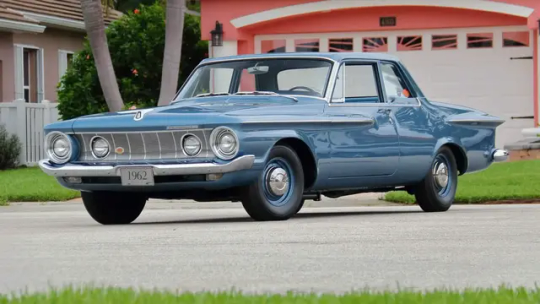
1962 Plymouth Savoy Max Wedge
In 1962, a new era of muscle cars emerged, radiating brilliance and power. Chrysler led the way with their groundbreaking Max Wedge lineup, introducing the world to the fusion of unitized-body construction and the high-performance ram-tuned dual-carbureted 413 CI engine. Among these legends was the Plymouth Savoy Max Wedge, a remarkable vehicle that holds a significant place in automotive history.
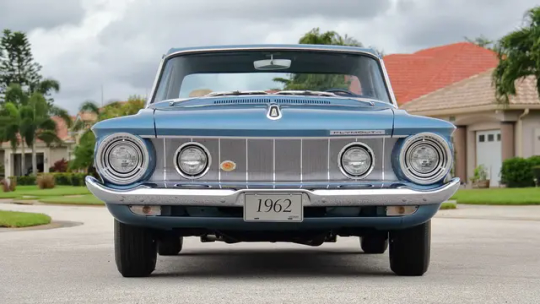
1962 Plymouth Savoy Max Wedge

1962 Plymouth Savoy Max Wedge
The First Super Stock Max Wedge with Manual Transmission According to the esteemed Chrysler Registry and the meticulous documentation by Darrell Davis, this specific Plymouth Savoy Max Wedge holds a groundbreaking distinction—it was the first Super Stock model equipped with a manual transmission. The car’s odometer displays a mere 6,593 miles and has undergone a meticulous restoration process to return it to its original specifications. Notably, the engine has been upgraded, boasting a dyno-proven power output exceeding 500 HP.
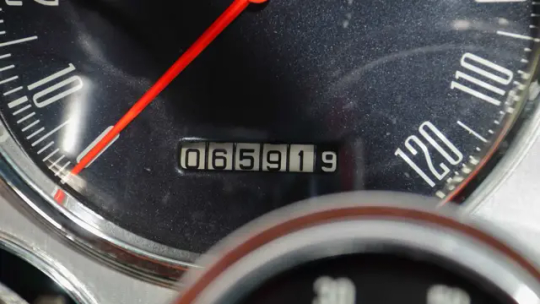
1962 Plymouth Savoy Max Wedge
Unleashing the Power of the 413 CI V-8 Engine The 1962 Plymouth Savoy Max Wedge was powered by the formidable 413 CI V-8 engine. This was the first iteration of Chrysler’s renowned ram induction system, featuring a cross-ram intake manifold meticulously designed to optimize engine efficiency. The engine’s performance was further enhanced by the utilization of cast-iron header-style manifolds, which were rarely preserved but featured in this exceptional vehicle. Dale Reed of California refreshed the engine around 300 miles ago, ensuring its optimal performance. The correct Carter AFB carburetors reside beneath dual black air cleaners, accentuated by carefully placed decals.
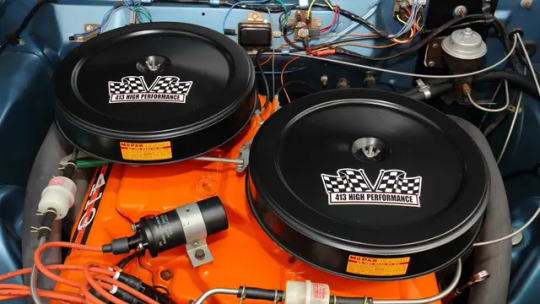
1962 Plymouth Savoy Max Wedge
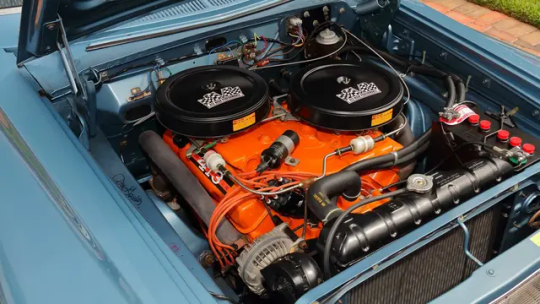
1962 Plymouth Savoy Max Wedge
A Unique Manual Transmission Experience One of the distinctive aspects of this Plymouth Savoy Max Wedge is its manual transmission. Unlike its automatic counterparts, this car delivers a unique driving experience through its floor-mounted shifter, allowing the driver to truly feel the power at their fingertips. Paired with a full aftermarket exhaust equipped with cutouts and the robust 8 ¾ Chrysler differential, this Max Wedge offers an exhilarating ride for those who crave the thrill of the open road.
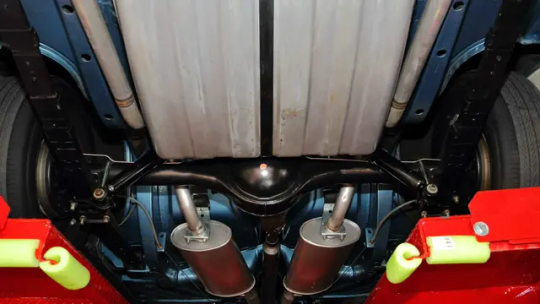
1962 Plymouth Savoy Max Wedge
Captivating Style and Authenticity The exterior of this Plymouth Savoy Max Wedge embodies the spirit of the era. Finished in captivating light blue paint, it exudes a timeless charm. The interior features a complementary blue cloth-and-vinyl combination, while the white-and-blue two-tone trim adds an elegant touch. The front and rear bench seats provide comfort, and the radio delete plate pays homage to the car’s performance-focused nature. Notably, it features a knee-knocker S-W column-mounted tachometer and a beautifully presented trio of rubber pedals. The car’s attention to detail is evident throughout, with the inclusion of circa-1962 chrome fonts, single-lens tail lamps, and OEM steel wheels adorned with poverty-type hubcaps.
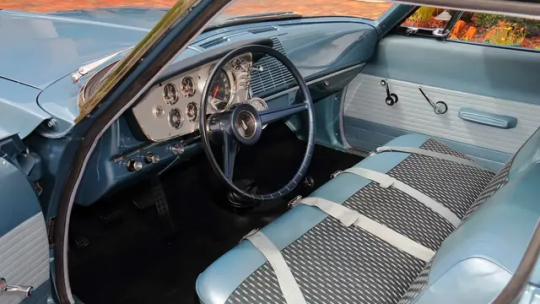
1962 Plymouth Savoy Max Wedge
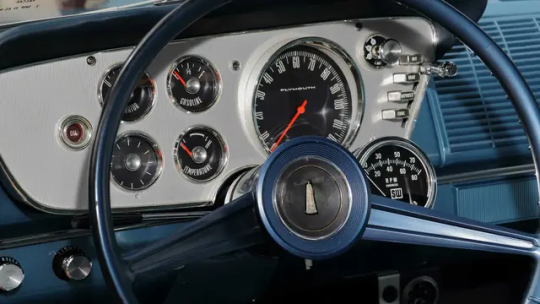
1962 Plymouth Savoy Max Wedge
Provenance and Documentation Accompanying this Plymouth Savoy Max Wedge is a wealth of provenance and documentation that adds to its allure. It includes the original OEM IBM punch card and build sheet, which serve as a testament to its authenticity. Additionally, the window sticker provides insight into its original specifications, while the dyno sheet confirms its impressive horsepower rating. Vintage photos capture the car’s early years when it was part of a famous drag car collection, showcasing its illustrious past.

1962 Plymouth Savoy Max Wedge

1962 Plymouth Savoy Max Wedge
Conclusion The 1962 Plymouth Savoy Max Wedge stands as a testament to the golden age of muscle cars. With its groundbreaking manual transmission configuration, powerful 413 CI V-8 engine, and captivating style, it represents the pinnacle of Mopar’s storied performance heritage. Meticulously restored to its original glory, this Max Wedge allows enthusiasts to experience a bygone era’s raw power and timeless charm.
FAQs: How many miles does the 1962 Plymouth Savoy Max Wedge have? The odometer of the 1962 Plymouth Savoy Max Wedge reads 6,593 miles. Who documented the Chrysler Registry for this particular car? The meticulous documentation of the Chrysler Registry for this car was done by Darrell Davis. Has the engine of the 1962 Plymouth Savoy Max Wedge been upgraded? Yes, the engine of this Plymouth Savoy Max Wedge has been upgraded to a dyno-proven 500-plus HP. What is the significance of the 413 CI V-8 engine in this car? The 413 CI V-8 engine in this car was the first to receive Chrysler’s shortened version of ram induction, known as the cross-ram intake. It maximizes engine efficiency and pairs it with rarely preserved cast-iron header-style manifolds. What documentation and provenance come with this Plymouth Savoy Max Wedge? This Plymouth Savoy Max Wedge comes with various documentation, including the OEM IBM punch card, build sheet, window sticker, dyno sheet confirming horsepower rating, and vintage photos of its early years as part of a famous drag car collection.
#Plymouth Savoy Max Wedge#Plymouth Savoy#plymouth#Max Wedge#car#cars#muscle car#american muscle#mopar#moparperformance#moparnation#moparworld
95 notes
·
View notes
Text
The Far Roofs
So today I want to talk a bit about what this game wants to be. In particular, I'm going to go over its key technical and artistic goals.
The Far Roofs focuses on immersive hidden world fantasy adventure. It's intended to offer the experience of a grounded, emotionally real base world attached to an idealized, fantastic "hidden world" setting.
One might say, the streets and buildings and houses of the game's world are basically our own. Above us, though, is a stranger, more idealized, and more fantastic place. It's hard to get to. It's dangerous. It's less grounded. It's full of wonder.
Those are the Far Roofs.
This divide exists to make the game feel as real as possible, if you want to go that way. That's part of what hidden world fantasy is about, after all---the idea that magic is here. That it's not in some distant alien land or mythic future or past.
It's here, if you want to reach for it.
(Now, the game is flexible enough that you can play "protagonist" types instead of realer people, and many traditional gaming groups will probably prefer that, but that'll mean getting less of that immersive effect.)
The mood the game is interested in is that feeling you get when you take a huge risk---move to a new place; try a new thing. The feeling you get in those times in your life when everything is alienated and wondrous and terrifying but there's also so much more *hope* than there was in the still times before.
It's a mood of being swept up and called forward.
This is, among other things, meant to be a game for people who've been beaten down or exhausted by the ... everything ... to feel that sensation of moving forward again.
To remember what it's like, why it's worth it, how to reach for it again.
It's meant---and I do understand that I am finite and flawed and this can only go so far---as a tonic and refreshment to the soul.
--
Rules
The Far Roofs uses a 5d6-based dice pool system for day-to-day task resolution. It's relatively traditional and optimized for fast, fun dice reading. There's a loose consensus I've seen in RPG design circles that dice are for when outcomes are uncertain and both options are interesting, and I don't disagree ... but there's also this thing where rolling dice to decide is intrinsically interesting and fun, where it's fuel for a certain part of the brain.
This game tries to get as much out of that side of dice as it can.
You'll also collect letter tiles and cards over the course of the game. This is for bigger-picture stuff:
To answer big questions and to complete big projects, you'll either assemble representative words out of those tiles, or, play a poker hand built out of those cards. Word and their nuances express ideas and shape how outcomes play out; poker hands, conversely, just give a qualitative measure of how much work you do or how well things will go.
In keeping with this, the campaign is represented principally in the form of questions or issues your words and hands can address. Player/GM-created campaigns would be the same.
--
Physical and Electronic Product
I wanted to put the print version within the range of as many people who might need that tonic as possible. That means that for this particular game, I wanted to cover the full territory that I'd normally cover in a two or three volume set (core rules, setting, and campaign) in a single 200-250-page volume.
In practice this means there's a guide and examples for constructing the setting, rather than a deep dive into a fully-detailed world; that there's a bit less in the way of whimsical digression and flourish than in the writing I'm known for; that there's minimal "flavor" text on abilities; and that the campaign presentation is pretty fast-paced.
Conversely, it means that the game should be easy to absorb and to share with other possible players, and, that the game and campaign in this one relatively small volume should provide enough content for five or six years of play.
The book will be 8.5"x11" with grayscale art, available in a limited hardcover print run and a print-on-demand softcover form.
--
On the Rats
You'll see a lot of talk from me and others about the talking rats in this game. They're one of the jewels of the experience, and I think they're probably a significant draw just for being talking rats that are core to the game.
... but I'm going to hold off for now, because, to be clear, this is not a game of playing talking rats. It's just a game where talking rats and probably one of the top three most important setting elements.
I couldn't get that feeling I wanted of ... the base world being grounded realism; of the hidden world pulling you up and out and into a world full of magic ... with your playing rats, with your playing something so distant from the typical player.
So this is not a game of playing them.
They're just ... I like rats, and so I made the rats in this game with love. They're great ... whatever the equivalent is to "psychopomps" is for a magical world instead of for death ... and a way of talking about how in the face of the world, we're all pretty small.
--
I'm really excited about this game; the playtest was lovely.
I hope you'll enjoy it as well!
198 notes
·
View notes
Text


HELLO my first fic is finally done!!!! im posting some of the intro under the cut, but the whole thing is up on AO3!! (pls dont look at the word count it's really embarrassing)
It’s days like this that make Boothill consider giving up on his hunt.
Well, consider is too strong a word; it’s only ever a passing fancy, a brief flicker of doubt that he discards immediately. He’s a man on a mission, after all, and he’s nothing if not determined. He's proud of his ruthless optimism in the face of adversity; it's kept him going this long. Still, he’s willing to admit that work like his isn’t all sunshine, and certainly has its rainy days – this one definitely included.
He’s finally on his way home after an exceptionally long and frustrating job, one that seemed engineered to piss him off, one that he failed, and he’s eager to get back to your shared apartment, clean up, recharge, and spend some desperately needed time with you. He’d sent you a message to let you know he was on his way back a few system hours ago, and you’d excitedly responded with a string of emojis so long it filled his entire phone screen. The hour is rather late for you to be up – not terribly late, but enough that he's lucky you're awake.
He’s exhausted and frustrated and filthy and he absolutely reeks; he didn’t have the time to clean up before heading back, and frankly, even if he did, he thinks he might’ve combusted on the spot if he spent another second on that god-forsaken bog of a planet. As he climbs the stairs up to the apartment, he's nearly tempted to collapse on them and pass out for a few hours, but the urge to see you keeps him moving.
“I’m home, sweetpea,” he calls as the door shuts behind him. He retracts the spurs on his ankles and sluggishly wipes his feet on the mat – a habit you’d been sure to instill in him the moment the two of you started living together. (“You always track in so much dirt! And no, just because you technically don't wear boots doesn't mean you don't have to wipe off the mud,” you scolded him. “Maybe I should start making you clean it up.” That straightened him out real quick.) His hat is hung in its designated spot next to your favorite jacket, looking exceptionally out of place considering the grime that coats it.
He slumps against the door, utterly drained, then tilts his head at your lack of response. You’re home and awake, he knows that much; your usual shoes are by the door, and he can hear movement in the kitchen. A tantalizing smell radiates into the entryway, and he’s willing to bet it’s some kind of stew; you always make it on days that you know he’s coming home.
He turns the corner around the kitchen and finds you with your back to him, busy with something on the stove, then sees why you hadn't answered him; you've got your headphones on, moving to a beat he can just barely hear, muttering along to it under your breath. His lips quirk, fondness unfurling in his chest; a little spark of mischief arrives on its coattails, chasing away his exhaustion for the moment. He steps lightly onto the tile, quieter than he needs to be, eyes glimmering. Closer, closer, closer he creeps, until he's towering behind you, just within reach. With a glance, he makes sure you aren't holding anything too important, and then–
You squeal in surprise as his arms snake around your waist, hauling you back against his chest with unyielding strength. With a mighty squirm, you whip around to identify your attacker, and your face lights up so perfectly that if he wasn't grinning before, he certainly is now. You laugh in delight, rushing to shake off your headphones and shove them onto the counter. The moment your hands are free, you leap against him in earnest, hard enough that he'd stumble if he weren't made of metal.
You curl your arms tightly around his shoulders, wrapping your legs around his hips in a death grip like you’re trying to crush him, as you always do. His hands slip down beneath your thighs to support you in your efforts, as he always does.
Either you don't notice how filthy he is (very hard to believe) or you don't care, because you pepper his face with kisses relentlessly. By the time you're done with your assault, he's chuckling, all dazed and giddy, his weariness melting away at your touch. Cupping your hands around his face, you beam at him, eyes shining.
“Hi, honeybee,” you say, a little breathless.
“Hey there, buttercup,” he answers with a squeeze on your thighs. He resists the urge to rub his cheek against yours as he usually does, conscious of the grime that coats him like a second skin. “Did ya miss me that much?”
You scoff and roll your eyes as dramatically as you can manage. “Like you even need to ask. Feels like it’s been forever.” You pinch his cheeks, then laugh as he nips at your fingers. “How was the mission?”
He groans, and he isn't even exaggerating. (read more on ao3 !!)
#boothill#boothill x reader#hsr x reader#hsr#honkai star rail#x reader#reader insert#sal.txt#very excited for some of my future fics!! i have so many things planned it's absurd lol#Darling Daisies; Busy Bees
44 notes
·
View notes
Text
Part of the problem with Fate Grand Order is the core gameplay is fundamentally flawed, and it's very difficult to restore "a fun game" around a flawed core.
Quick and Buster and Arts were all interesting notions, and could have mapped into action gameplay (if we were to merge FGO's ideas with FSR's gameplay I would equate them to fast attacks, heavy attacks, and weaker attacks meant to charge your special bar, but I digress).
As it is, though, it just makes for unpleasant feelings in gameplay, demanding optimizations (I would point out that in the international release we only recently got the ability to combo all three together, and made Quick chains strong enough to consider independently). Those optimizations rise up around every aspect of the game; only a select few Servants have the ability to AoE without accessing their Noble Phantasm, and they haven't even made it to international. There's a wide range of Craft Essences, but only a few that ever matter. Creativity in builds is tamped down around increasingly narrowed build notions as the devs design with over-optimized teams in mind.
The end result is a game that, optimally, advises you to use your super rare fully powered optimized support, your friends' identically super rare fully powered optimized support, and a high power damage Servant, and repeatedly fire the damage dealer's Noble Phantasm to either clear waves or kill bosses.
Speaking of which, from a lore perspective, this is also completely messed up. By the lore of the Nasuverse, a Noble Phantasm is a Servant's super secret ultimate move, only meant for the final hour. This is fully incongruous with the gameplay, where you typically throw the same world-ending mythology-defining techniques three times in a row and call it a day. (Entertainingly, in the International release, we've also made it to Traum, where we see faceless Servants fire their Noble Phantasms like simple artillery, but that's its own commentary.)
Like, it's so effortless to imagine better systems than this! Servants deployed on a chessboard-like map, heralding back to the themes of Fate Apocrypha; suddenly we don't need anything as mechanically obtuse as Class Advantages when we could organically differentiate each Class by how they navigate the board or how they fight each other (Riders can leap over enemies like knight pieces in chess; Archers can attack at range without moving; Lancers do really well on Attack but have poor Defense; and Berserkers can be the units of terror that lore implies!)
Alternatively, the Grail Battlefronts we've already seen- rework the entire game to operate more organically like that; maybe Servants can use skills without entering combat, but it exhausts their actions. Then different forms of gameplay can exist beyond just "mulch the enemy"; like "defend this location" or "collect these resources" or "defeat This Particular Foe".
Or, even if we had to work with just the system we have! Change THAT! Rather than select three cards from a set of five, have it go down the list; each Servant gets One Action to either pick from "Quick, Buster, Arts, Use A Skill".
As for Servant Customization, walk it all the way back, all the way back up to the Attack/HP boosting. Make it so that players can individually optimize Servant performance in different ways- this Servant has better output in Arts, that Servant has higher Crit Star generation. And for folks who'd already spent their Fous, you could just say "right, so anybody with Fous spent can now allocate those points into these new Stats! No harm done!"
Of course, in order to do this, they would likely need to construct a whole new framework for their game, whilst preserving the progress people have made until now.
Then again, they are presently building castles in the sand during the rising tide with one hand and bandaging bullet wounds with the other, so maybe a long shot like that is what they need.
#fgo#fate grand order#my ramble box#maybe my next ramble box will be How I Would Make A Better FGO from the ground up
47 notes
·
View notes
Text





AVO Impreza WRX & STI Subaru GDA/GDB Pure Power Packages.
AVO knows Subaru better than anyone else.
Since the introduction of the 4-cylinder turbo, we have spent over 34 years of experience pursuing faster driving.
From AVO's unique turbochargers to intercoolers to match all power levels.
AVO Turbo World is an industry leader in the design and production of turbo systems.
We follow a unique engineering philosophy that emphasizes efficiency and efficiency, without relying on dangerously high boost pressures. This is manifested in the following four company principles: optimization of the intake system, opening of the exhaust, thereby creating the best intercooler, and absolute excellence in engine management that integrates the entire package. Do not cause non-conformity to the application. Thousands of hours of design and testing go into every WRX and STI performance part, but most of that time is spent doing what we think is most important. . This means that all turbo systems work seamlessly with the original engine, transmission, and electrical system. Our ``Subaru Performance Program'' is based on the quality of its design, perfection, materials and manufacturing technology.
We are unrivaled in this area. When carefully selected and correctly equipped, you will experience intense power and driving pleasure.
With our accurate service and maintenance, you can enjoy years of trouble-free enjoyment.
AVO Edge Series Ball Bearing Turbocharger
Are you looking for that extra edge in your races? AVO's Edge series, ball bearings.
How about a turbocharger? Our turbochargers, which have been recognized around the world for many years, are available in a variety of sizes to suit any size. With turbochargers supplied all over the world, you can't expect better performance, response, and drivability on both public roads and races. Water and oil cooling provides maximum reliability in all conditions.
12 notes
·
View notes
Text
Building a cargo spaceship capable of exploring our solar system based on current technology and the knowledge gleaned from our understanding of engineering, science, and chemistry requires us to work within practical and realistic constraints, given that we're not yet in an era of faster-than-light travel. This project would involve a modular design, reliable propulsion systems, life support, cargo handling, and advanced automation or AI. Here’s a conceptual breakdown:

1. Ship Structure
Hull and Frame: A spaceship designed for deep space exploration needs a durable, lightweight frame. Advanced materials like titanium alloys and carbon-fiber composites would be used to ensure structural integrity under the stress of space travel while keeping the mass low. The outer hull would be made with multi-layered insulation to protect against micrometeorites and space radiation.
Dimensions: A cargo space vessel could be roughly 80-100 meters long and 30 meters wide, giving it sufficient space for cargo holds, living quarters, and propulsion systems.
Cost: $500 million (materials, assembly, and insulation).
2. Propulsion Systems
Primary Propulsion: Nuclear Thermal Propulsion (NTP) or Nuclear Electric Propulsion (NEP):
NTP would involve heating hydrogen with a nuclear reactor to achieve high exhaust velocities, providing faster travel times across the solar system. NEP converts nuclear energy into electricity, driving highly efficient ion thrusters. Both systems offer relatively efficient interplanetary travel.
A hybrid solution between NTP and NEP could optimize fuel efficiency for longer trips and maneuverability near celestial bodies.
Cost: $1 billion (development of nuclear propulsion, reactors, and installation).
Fuel: For NTP, hydrogen would be used as a propellant; for NEP, xenon or argon would be the ionized fuel. It would be replenished through in-space refueling depots or by mining water on asteroids and moons (future prospect).
Cost (fuel): $50 million.
3. Power Systems
Nuclear Fission Reactor: A compact fission reactor would power the ship’s life support, propulsion, and onboard systems. Reactors designed by NASA’s Kilopower project would provide consistent energy for long missions.
Backup Solar Arrays: Solar panels, optimized for efficiency beyond Mars’ orbit, would serve as secondary power sources in case of reactor failure.
Cost: $300 million (including reactors, solar panels, and energy storage systems).
4. Cargo Modules
The cargo holds need to be pressurized and temperature-controlled for sensitive materials or scientific samples, while some holds could be left unpressurized for bulk materials like metals, water, or fuel.
Modular Design: The ship should have detachable cargo pods for easy unloading and resupply at different planetary bodies or space stations.
Cost: $200 million (modular design, pressurization systems, automation).
5. Life Support Systems
Water and Oxygen Recycling: Systems like NASA’s Environmental Control and Life Support System (ECLSS) would recycle water, oxygen, and even waste. These systems are key for long-duration missions where resupply may be limited.
CO2 Scrubbers: To remove carbon dioxide from the air, maintaining breathable conditions for the crew.
Artificial Gravity (optional): A rotating section of the ship could generate artificial gravity through centripetal force, improving the crew’s health on longer missions. However, this would increase complexity and cost.
Cost: $200 million (life support systems, with optional artificial gravity setup).
6. AI and Automation
AI-Controlled Systems: AI would manage navigation, propulsion optimization, cargo handling, and even medical diagnostics. Automated drones could be used for ship maintenance and repairs in space.
Navigation: Advanced AI would assist in calculating complex orbital maneuvers, interplanetary transfers, and landings.
Autonomous Cargo Handling: Robotics and AI would ensure that cargo can be efficiently moved between space stations, planets, and the ship.
Cost: $150 million (AI development, robotics, automation).
7. Communication and Sensors
Communication Arrays: High-gain antennas would allow for deep-space communication back to Earth, supplemented by laser communication systems for high-speed data transfers.
Radars and Sensors: For mapping asteroid belts, detecting anomalies, and navigating planets, advanced LIDAR, radar, and spectrometers would be necessary. These sensors would aid in planetary exploration and mining operations.
Cost: $100 million (communication systems, sensors, and diagnostics).
8. Radiation Protection
Water Shielding: Water, which is also used in life support, would double as a radiation shield around the living quarters.
Electromagnetic Shields: Experimental concepts involve creating a small electromagnetic field around the ship to deflect solar and cosmic radiation (early TRL, requires more development).
Cost: $50 million (radiation shielding).
9. Crew Quarters
Living Quarters: Designed for long-duration missions with the capability to house 4-6 crew members comfortably. The quarters would feature radiation protection, artificial lighting cycles to simulate day and night, and recreational facilities to maintain crew morale on multi-year missions.
Medical Bay: An AI-assisted medical bay equipped with robotic surgery and telemedicine would ensure the crew remains healthy.
Cost: $100 million (crew quarters, recreational facilities, medical systems).
10. Landing and Exploration Modules
Surface Exploration Vehicles: For landing on moons or planets like Mars or Europa, a modular lander or rover system would be required. These vehicles would use methane/oxygen engines or electric propulsion to take off and land on various celestial bodies.
Cost: $300 million (lander, rovers, exploration modules).
---
Total Estimated Cost: $2.95 Billion
Additional Considerations:
1. Launch Vehicles: To get the spacecraft into orbit, you would need a heavy-lift rocket like SpaceX’s Starship or NASA’s Space Launch System (SLS). Multiple launches may be required to assemble the ship in orbit.
Cost (launch): $500 million (several launches).
2. In-Space Assembly: The ship would likely be built and assembled in low-Earth orbit (LEO), with components brought up in stages by heavy-lift rockets.
Cost: $200 million (orbital assembly infrastructure and operations).
---
Grand Total: $3.65 Billion
This estimate provides a general cost breakdown for building a cargo spaceship that could explore and transport materials across the solar system. This concept ship is realistic based on near-future technologies, leveraging both nuclear propulsion and automation to ensure efficient exploration and cargo transportation across the solar system.
#canada#canadian politics#space#science#scifi#scifiart#sci fi and fantasy#nasa#nasa photos#elon musk#share#engineering#ideas#ai#scientificresearch#billionaire
6 notes
·
View notes
Text
Leading Brands in BLDC Exhaust Fan Technology
Introducing Intellifan: The Pioneering BLDC Exhaust Fan Manufacturer
Intellifan happens to be one of the most talked-about names in the industry related to designing, developing, and manufacturing superior-quality Brushless DC BLDC exhaust fans. Innovation and customer satisfaction are at the heart of this brand, and that is what has made Intellifan stand out as one of the leading BLDC exhaust fan manufacturers for different industries and applications.
The Need for Efficient Exhaust Fans
In today's fast-paced industrial landscape, efficient ventilation systems play a crucial role in maintaining a healthy and safe working environment. Exhaust fans are an essential component of these systems, responsible for removing heat, fumes, and pollutants from the air. However, traditional exhaust fans often fall short in terms of energy efficiency, noise levels, and reliability. This is where Intellifan's BLDC exhaust fans come into the picture, offering a superior alternative to conventional exhaust fan technology.

BLDC exhaust fans
Advantages of the BLDC Technology
Intellifan's BLDC exhaust fans are touted to set new standards in performance, energy efficiency, and reliability. Some key advantages of the technology will be:
Higher Energy Efficiency: BLDC motors use significantly lesser power compared to conventional induction motors. This guarantees huge savings on energy and much reduced operating costs. Quieter Operation: The BLDC fans run at considerably lower noise levels, which makes for a more comfortable working environment and disturbances all minimized or nil. More Reliability: BLDC motors are built to be much more robust, long-lasting, and maintenance-free. Improved Airflow: Intellifan-designed BLDC exhaust fans are intended for superior airflow in the right direction towards proper ventilation and removal of heat. Intellifan Range of BLDC Exhaust Fan Range
Intellifan offers a whole range of BLDC exhaust fans to cope with all sorts of industrial applications falling under different needs and requirements. Our product umbrella includes:
Axial Fans: Axial fans find perfect applications in general ventilation due to their design for high airflow and low pressure. Centrifugal Fans: These are suitable in high-pressure applications. These ensure effective airflow, thus finding application in dust collection systems. Mixed Flow Fans: These fans combine the benefits of both axial and centrifugal fans. They offer a high flow with moderate pressure. Key Features and Benefits
The BLDC exhaust fans by Intellifan come with the following major features and benefits:
Advanced Motor Technology: Our BLDC motors are built with high-quality components, ensuring reliable operation and extended lifespan. Aerodynamically Optimized Design: Intellifan's fans are designed to provide maximum airflow while minimizing energy consumption. Easy Installation and Maintenance: Our fans are designed for easy installation and maintenance, reducing downtime and increasing productivity. Customization Options: Intellifan offers customization options to meet specific industry requirements and application needs. Industry Applications
IntelliFan BLDC exhaust fans can be applied in broad industries such as:
Industrial Manufacturing: Efficient ventilation and extraction of heat are key in the context of industrial manufacturing.
Heating, Ventilation, and Air Conditioning Systems: IntelliFan fans are highly applicable to HVAC systems.
Agricultural Purposes: Our fans apply in agriculture for ventilation and cooling livestock and plants. Commercial and Residential Buildings: Intellifan's fans are used both in commercial and residential buildings to ensure proper ventilation and air circulation.
Why Choose Intellifan?
When it comes time to choose a reliable BLDC exhaust fan manufacturer, Intellifan makes a strong case against the competition. Here are just a few reasons why:
Proven Track Record: Intellifan has a proven track record of high-quality products with exceptional customer service. Only at INTELLIFAN: Because of our commitment to innovation, our products are ahead of the curve with the latest technologies and features for customers. Customer Options Available: For Meeting Industry-Specific Needs and Application Requirements Competitive Pricing: The products offered by Intellifan are competitively priced and offer the customer an economical solution for their ventilation needs.
Conclusion
Intellifan is the pioneering and leading manufacturer of BLDC exhaust fans, true to its commitment of offering quality products and outstanding customer service. Our determination to become innovative, energy-efficient, and reliable has earned us the leading name in the industry. From industrial and commercial to residential, the need for efficient ventilation finds its best solution in Intellifan.
visit:- https://www.bldcfan.in/bldc-exhaust-fan/ Address: 13, Prakash Industrial Estate, Sahibabad Industrial Area Site 4, Sahibabad, Ghaziabad, Uttar Pradesh 201005
3 notes
·
View notes
Text
Why Does a Generator Need a Load Bank?
Generators play a crucial role in providing power in various scenarios, from emergency backup during power outages to primary power sources in remote locations. Ensuring the reliability and efficiency of a generator is paramount, and one of the key tools in achieving this is a load bank.
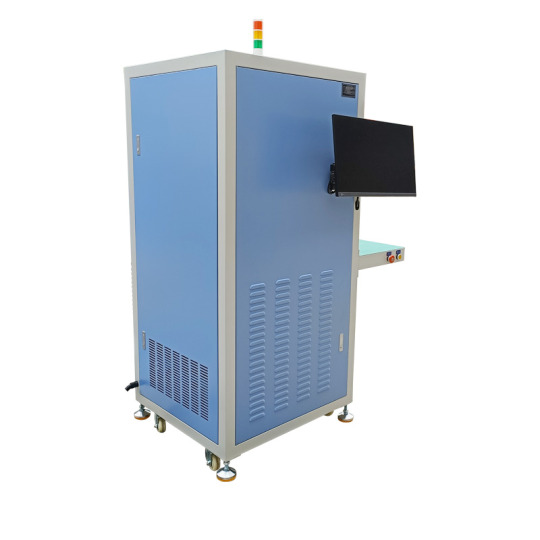
What is a Load Bank?
A load bank is a device designed to provide an artificial load to an electrical power source, such as a generator. This load mimics the operational or "real-world" load that the generator would encounter during actual use. Load banks can be categorized into three main types:
Resistive Load Banks: These simulate resistive loads, such as incandescent lighting and heating loads.
Reactive Load Banks: These simulate inductive loads, such as those found in motors and transformers.
Resistive/Reactive Load Banks: These provide a combination of both resistive and reactive loads to simulate more complex real-world conditions.
The Importance of Load Bank Testing
1. Verifying Generator Performance
Generators are often kept on standby for emergencies, which means they may not be used frequently. Regular load bank testing ensures that the generator is capable of handling its rated capacity when needed. This helps identify any performance issues that could lead to failures during actual operation.
2. Preventing Wet Stacking
Diesel generators, in particular, are prone to a condition known as wet stacking when operated at low loads for extended periods. Wet stacking occurs when unburned fuel accumulates in the exhaust system, leading to reduced efficiency and potential damage. Load bank testing helps prevent wet stacking by running the generator at higher loads, ensuring complete combustion of fuel.
3. Ensuring Proper Cooling
Generators are designed to operate at specific loads to maintain optimal cooling. Running a generator under low or no load can cause inadequate cooling, leading to overheating and potential damage. Load banks help maintain proper operating temperatures by applying appropriate loads during testing.
4. Identifying Potential Issues Early
Load bank testing can reveal hidden issues that might not be apparent during normal operation. These issues could include problems with the generator's electrical and mechanical systems, fuel system, or cooling system. Identifying and addressing these problems early can prevent costly repairs and downtime.
5. Compliance with Regulations
Many industries and jurisdictions have regulations that require regular load bank testing for backup generators. Compliance with these regulations is essential to ensure the safety and reliability of power systems. Using a load bank helps meet these regulatory requirements and avoid potential fines or penalties.
How Load Banks Work
Load banks simulate the load that a generator would encounter during actual use by converting electrical energy into heat. This process involves:
Connecting the Load Bank: The load bank is connected to the generator, typically through a series of power cables.
Applying the Load: The load bank applies a controlled load to the generator, which can be adjusted to simulate different load conditions.
Monitoring Performance: The generator's performance is monitored during the test, including parameters such as voltage, current, frequency, and temperature.
Analyzing Results: The data collected during the test is analyzed to identify any performance issues or potential areas for improvement.
The Role of EMAX Load Banks
At EMAX, we understand the critical importance of maintaining reliable generator performance. Our range of load banks is designed to meet the highest standards of quality and reliability, ensuring that your generators are always ready to perform when needed.
1. Advanced Testing Capabilities
EMAX load banks offer advanced testing capabilities, allowing for precise control and monitoring of load conditions. Our load banks are equipped with state-of-the-art instrumentation to provide accurate data on generator performance, helping you identify and address any issues quickly.
2. Versatility and Flexibility
EMAX load banks are designed to be versatile and flexible, capable of handling a wide range of load conditions. Whether you need resistive, reactive, or combined load testing, our load banks can meet your specific requirements.
3. Durability and Reliability
Built with robust materials and components, EMAX load banks are designed to withstand the rigors of regular testing. Our load banks are engineered for long-term reliability, ensuring that they can provide consistent performance over many years of use.
4. Ease of Use
EMAX load banks are user-friendly, with intuitive controls and interfaces that make testing straightforward and efficient. Our load banks are designed to be easy to set up and operate, allowing you to conduct tests quickly and accurately.
Conclusion
Load bank testing is a critical component of generator maintenance, ensuring that your generators are always ready to perform when needed. By providing controlled loads and precise monitoring, load banks help verify generator performance, prevent issues like wet stacking, and ensure compliance with regulations. EMAX load banks offer advanced testing capabilities, versatility, durability, and ease of use, making them the ideal choice for maintaining reliable power systems.
Investing in EMAX load banks is an investment in the reliability and efficiency of your generators. With EMAX, you can be confident that your generators will be ready to deliver power when it matters most. Contact us today to learn more about our range of load banks and how they can benefit your power systems.
3 notes
·
View notes
Photo









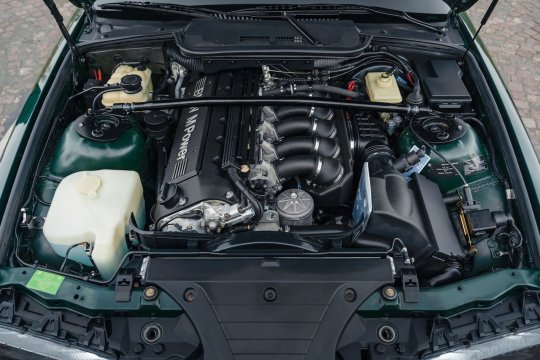
BMW M3 GT
The BMW M3 e36 was not designed for competition, unlike the M3 E30. The goal of the M3 is now to offer the brand's customers a real road GT. But the birth of the ephemeral GT version in 1995, at the crossroads of the M3 e36 3.0 and 3.2, comes once again from the needs of racing... The M3 GT is a pure niche product reserved for old Europe, where only well-informed connoisseurs can rejoice at not having air conditioning... which is however not the case here. At first glance, neophytes will see nothing but a "tuned" BMW. This generation having been largely consumed at the stake of racing, we will not really blame them. The M3 GTs thus adopt the white indicators "theoretically" reserved for the M3 3.2L at the front, but the side and rear indicators of the M3 3.0.
All M3 GTs therefore sport the same color British Racing Green (312), a color exclusively reserved for this model. Then, we attack the stimulating signals for emotional enthusiasts: the blade (adjustable in two positions) added under the front spoiler, the trunk spoiler borrowed from the competition 318is (and not the one offered as an option on the M3 coupe with 3rd light stop), or as an option on the M3 GTR, the small "BMW Motorsport International" logos with a blue and red checkerboard replacing the traditional M on the moldings and door sills, the 17" forged aluminum rims, polished and engraved with a large "BMW Motorsport" in their center.The panoply is complete but still relatively sober so as not to disturb the natural elegance of the lines of the BMW e36 coupé. On board the M3 GT, we also go green. There are thus standard sports seats covered in their center with Mexico green nappa leather and anthracite Amaretta on the bolsters. The same green leather is also present on the storm doors. Another special feature of the GT, a carbon fiber veneer on the bottom of the center console and above the glove box. The three-spoke sports steering wheel incorporates the airbag. Under the bonnet, a strut bar hangs over the superb 6-throttle intake manifold of the 3.0 engine (code S50B30) from Motoren Werke of Bavaria. Revisited for the occasion, it was offered more pointed camshafts and electronic management of the recalibrated Vanos system. The M3 gains 9 additional hp and a chouille of torque 32.9 mkg at 3900 rpm (instead of 32.6 at 3600). On the other hand, what the figures do not reflect is the even more explosive character of this 6 in line of anthology. It is even more furious in the 5000-7300 rpm range (cut-off speed), with an inexhaustible will to the rev limiter. In addition, the engineers considered it useful to optimize the lubrication of the S50 with a partitioned crankcase and more powerful pumps for use on the circuit. The exhaust line is the same, however, but the 3.0 lets you get drunk on its metallic and refined sound even better.
38 notes
·
View notes
Text

B-52 pilots test new instruments to facilitate the flight of BUFF
Fernando Valduga By Fernando Valduga 10/11/2023 - 08:21 in Military
As the B-52 fleet prepares for new engines, radars and other technological upgrades, a team of test pilots and engineers from Edwards Air Base, California, wants to make the old bomber easier for crews to operate.
Specifically, they are testing new instrumentation, including sets of digital motor meters to replace the current analog meters.
The meter groups show information such as fuel flow and exhaust temperature for each of the B-52's eight engines, which helps pilots check for problems and identify defects. The goal is to make the cabin more intuitive so that pilots can devote more attention to fulfilling the missions.
“Piloting the plane is the first step and using it as a weapons system is the final step,” Lieutenant Colonel Scott Pontzer, commander of the 419º Flight Test Squadron and director of the Combined Global Bomber Test Force, said in a press release on August 22. "So if I can reduce the pilot's workload... I can reduce the general brain task."
The concept of human systems integration, where the systems are adapted to the operator and not vice versa, did not exist when the B-52 cabin was first designed in the late 1940s, said Dave Prakash, a former B-52 operational test pilot and flight operator.

A B-52 Stratofortress test pilot operates a flight simulator while using one of three new prototype flight instruments at Edwards Air Base, California. (Photo: US Air Force / Giancarlo Casem)
“Whether motor instruments or navigation instruments, they are all designed to fit compactly into existing space, but they were not designed to be easy to use,” he said.
For example, pilots perform cross-checks routinely, where they quickly check their air speed indicator, vertical speed indicator, tilt angle and other instruments to make a decision. Weather is essential, especially during a delicate procedure such as landing at night or in adverse weather conditions. But the way the B-52 cabin is arranged can cost precious half a second or a quarter of a second.
"Instrument groups are not designed in the most efficient way for a pilot to do a cross-check," Prakash said. "In addition, the meters and instruments are not even consistent between the left and right pilot seats, so you have to do a different cross-check depending on the seat you are in."
youtube
The problem extends to the engine meters, which display the engine pressure ratio (EPR), fuel flow, exhaust gas temperature, rotations per minute (RPM) and oil pressure. During his time as a test pilot, Prakash analyzed how these and other systems, such as navigation, could be optimized for the operator.
"If it takes 20 button taps to do one thing, is there a way to press just two buttons?" he asked.
The Edwards testing team is working on the same issues as the B-52 Commercial Engine Replacement Program goes online. The switch to digital meters should make it easier for operators to quickly check the engines.
"This provides better accuracy, readability and error indications (for example, color changes), to name a few things," said Major Darin Flynn, B-52H test pilot of the 370º Flight Test Squadron. "We also have EPR demand indicators that greatly reduce the workload during the precise adjustment of the accelerator."
The pilots tested three different prototypes of groups of meters in a simulator and then received a questionnaire to record what they liked or dis liked in it.
“In fact, we are measuring their performance on these monitors and we are also getting very good comments, because now they have really seen what the monitors are like,” Flynn said in the statement. "This will help us select the best design option for the B-52."
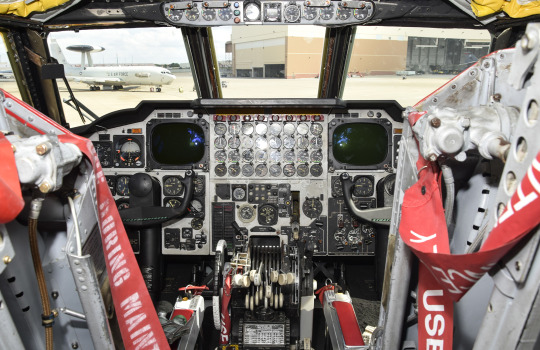
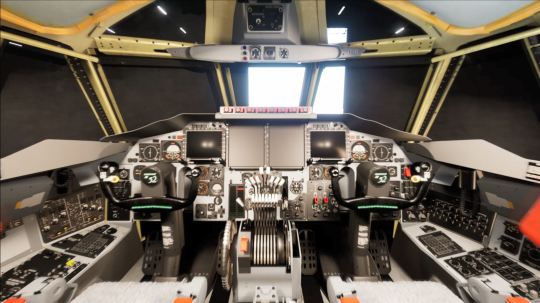
Differences between the cockpits of the B-52H and the future B-52J (below).
The new B-52 engines are militarized versions of Rolls-Royce's commercial BR725, and the B-52J software will be a mixture of commercial and military software, explained Flynn and Eric Treadwell, leaders of B-52's human crew systems/factors. In addition to the engine meter groups, the entire cockpit is undergoing a renovation, as the analog displays are replaced by large color multifunction screens.
“What they are doing is fantastic and absolutely critical,” Prakash said of the effort to integrate human systems.
There are still some dangers in better technologies: Prakash warned that problems can arise due to automation prejudice, which occurs when users do not notice failures in automated decision-making systems (such as when spell checking suggests the wrong word); and the fatigue of alarms, where users become insensitive to beeps and recurring alarms that may indicate real danger. Flynn was not very concerned about the first.
"I don't think automation bias will really be a very important factor because, although we are getting new engines [digital engine control with full authority], there is little automation involved," he said. "There will be no automatic accelerators."
Military standards provide guidance to avoid problems such as automation bias and alarm fatigue, Treadwell explained. A working group of government engineers and contractors is also collaborating with B-52 pilots to evaluate and refine the project, a best practice in U.S. Air Force development programs.

“We have different levels of alerts that will be displayed or inhibited depending on the severity and phase of the flight,” Flynn said. "We have already identified some warnings of a commercial nature and not applicable to military use."
In the future, the Edwards team hopes to collaborate with maintainers to get their opinion on digital instruments and whether this would affect their work.
“We can solve problems before they become problems,” Pontzer said in the press release. “Being at the forefront, between Boeing, the 418º FLTS and the [Test Pilot School], all of us working together to use robust systems and proven test methodologies to make good decisions is incredible for the combatant.”
Source: Air Force & Space Magazine
Tags: Military AviationBoeing B-52H StratofortressUSAF - United States Air Force / U.S. Air Force
Sharing
tweet
Fernando Valduga
Fernando Valduga
Aviation photographer and pilot since 1992, has participated in several events and air operations, such as Cruzex, AirVenture, Dayton Airshow and FIDAE. He has work published in specialized aviation magazines in Brazil and abroad. Uses Canon equipment during his photographic work in the world of aviation.
Related news
WAR ZONES
US intends to send second aircraft carrier to the coast of Israel
10/10/2023 - 22:42
The A-29 Super Tucano aircraft will make five demonstrations throughout the south of the country. (Photo: Jefferson Sampaio Valduga / Cavok Brazil)
SMOKE SQUAD
Smoke Squadron starts tour of the South of the country with demonstration in Bento Gonçalves
10/10/2023 - 20:30
A Super Puma helicopters from the Ecuadorian Army. (Photo: JO1 MARC BOYD / Wikimedia Commons)
HELICOPTERS
Ecuador Army Aviation acquires five used Super Puma helicopters
10/10/2023 - 19:40
MILITARY
Airbus starts construction of new A400M maintenance center in Germany
10/10/2023 - 16:00
MILITARY
Poland receives third batch of Bayraktar TB2 drones
10/10/2023 - 14:00
BRAZILIAN AIR FORCE
IMAGES: FAB sends second KC-30 aircraft to repatriate Brazilians in Israel
10/10/2023 - 12:00
5 notes
·
View notes
Text
The Future of Auto Engine Cleaning: Innovations in Dry Ice Blasting
In the ever-evolving world of automotive technology, innovation is the driving force behind improvements in engine performance, environmental sustainability, and overall driving experience. As engines become more advanced, so do the methods used to clean and maintain them. One of the most promising innovations on the horizon is "dry ice blasting in automobile" engine cleaning, a revolutionary approach that is set to reshape the future of auto maintenance. In this blog post, we will explore the latest developments and the potential of Dry Ice Blasting in the Automotive Industry.
Dry Ice Blasting in Car Engine
The Importance of Engine Cleaning
A clean engine is not just a matter of aesthetics; it's crucial for optimal performance and efficiency. Over time, engines accumulate dirt, grime, carbon deposits, and other contaminants that can negatively impact their function. Regular engine cleaning is essential to maintain fuel efficiency, reduce emissions, prevent damage, and extend the life of the engine. In this context, the emerging technology of dry ice blasting promises to be a game-changer.
Traditional Engine Cleaning Methods
Before diving into the innovative aspects of dry ice blasting, let's take a quick look at the traditional methods for engine cleaning:
Chemical Cleaning: Chemical solvents and degreasers are commonly used to dissolve and remove dirt and grime. However, these chemicals can be harmful to the environment and pose health risks to those handling them.
Abrasive Cleaning: Sandblasting or other abrasive methods involve blasting particles at the engine surface to remove contaminants. These methods can be effective but also risk damaging engine components.
Water-Based Cleaning: High-pressure water jet cleaning is used to remove dirt, but it can result in water waste and may not be suitable for certain engine parts.
The Rise of Dry Ice Blasting
Dry ice blasting is a cutting-edge cleaning method that leverages solid carbon dioxide (CO2) pellets. When these pellets are propelled at high speeds and impact the surface to be cleaned, they undergo a process known as sublimation, transitioning directly from a solid to a gas. This sublimation process creates mini-explosions on the surface, effectively dislodging and removing contaminants.
What Sets Dry Ice Blasting Apart?
The adoption of dry ice blasting in the automotive industry is driven by several key advantages:
Non-Arasive: Unlike traditional abrasive methods, dry ice blasting is non-abrasive and gentle on engine components. This non-destructive approach ensures that the engine parts remain undamaged.
Eco-Friendly: Dry ice is a byproduct of industrial processes, making it an environmentally friendly choice. It produces no secondary waste, chemical residue, or harm to the environment.
Efficient: Dry ice blasting is a highly efficient cleaning method, reducing labor hours and downtime for the vehicle, which can lead to cost savings.
Versatile: It can be applied to a wide range of engine components, from the engine block to exhaust systems, making it a versatile solution for engine cleaning.
Safety: Dry ice blasting eliminates the need for toxic chemicals, enhancing the safety of those involved in the cleaning process.
Long-Term Benefits: Regular use of dry ice blasting can help prevent future contamination, extending the life and efficiency of engine parts.
Current Innovations in Dry Ice Blasting
Dry ice blasting in the automotive industry is continually evolving, with several noteworthy innovations taking place:
Precision Cleaning: Advanced nozzle designs and control systems allow for more precise cleaning, ensuring that contaminants are removed without affecting the underlying surface.
Integration with Robotics: The use of robots for dry ice blasting is gaining traction. This automation allows for consistent and efficient cleaning processes in manufacturing plants and repair shops.
Ergonomic Design: Improved ergonomic designs of dry ice blasting equipment enhance the comfort and safety of operators during the cleaning process.
Smart Monitoring: Real-time monitoring and data analysis during the cleaning process are becoming more prevalent. This data can help optimize the cleaning process and predict maintenance needs.
Enhanced Portability: Smaller, more portable dry ice blasting units are being developed, making it easier to access and clean hard-to-reach areas in engines.
The Future of Auto Engine Cleaning
So, what does the future hold for dry ice blasting in the automotive industry?
Increased Adoption: As awareness of the benefits of dry ice blasting spreads, it is expected that more automobile manufacturers, repair shops, and enthusiasts will adopt this innovative cleaning method.
Wider Range of Applications: Dry ice blasting is likely to be used for various automotive applications, such as paint removal, decarbonization, and the removal of other contaminants beyond dirt and grime.
Collaboration with Automation: The integration of dry ice blasting with automation, including robotics, will become more commonplace in manufacturing plants and maintenance facilities.
Enhanced Efficiency: Continuous advancements in nozzle design and automation will make dry ice blasting even more efficient and reliable.
Environmental Responsibility: As environmental regulations become more stringent, the automotive industry's commitment to sustainability will drive the adoption of eco-friendly cleaning methods like dry ice blasting.
Case Studies: Success Stories
Let's explore a couple of success stories that highlight the transformational impact of Dry Ice Blasting in Automotive Industry:
Case Study 1: An automobile manufacturing plant introduced dry ice blasting in their engine cleaning process. The result was a significant reduction in emissions, thanks to the elimination of toxic chemicals. This not only aligned with their environmental goals but also improved worker safety.
Case Study 2: A classic car restoration workshop integrated dry ice blasting into their restoration projects. This approach allowed them to restore vintage engines to their original glory without compromising their authenticity. It attracted environmentally conscious customers seeking sustainable restoration methods.
The future of auto engine cleaning is poised for transformation, and dry ice blasting is at the forefront of this change. As the automotive industry continues to embrace environmentally responsible practices, innovations in dry ice blasting will play a pivotal role. This technology is not only an effective cleaning method but also a sustainable and eco-friendly solution that promises to shape the future of engine maintenance in the automotive world. The road ahead looks cleaner, more efficient, and in harmony with our environment, thanks to dry ice blasting.
#dry ice#dryiceblasting#dryicecleaning#amsdryice#cleaning#cars#automobiles#carservice#car service near me#automotive
3 notes
·
View notes
Text
10 Must-Have Modifications for Your Mustang Convertible
Introduction:
Embarking on the journey of Mustang ownership is more than just a drive; it's a commitment to the exhilarating spirit of freedom and performance. At Mustang Mania, we understand the desire to make your Mustang Convertible truly yours. Here are the top 10 modifications that will elevate your driving experience and turn heads wherever the road takes you.
Performance Exhaust System:
Give your Mustang Convertible a roar that commands attention. Upgrading to a performance exhaust system not only enhances the auditory pleasure but also improves overall engine efficiency.
Custom Wheels and Tires:
Swap out the stock wheels for a set of mustang built that not only looks impressive but also enhances handling and performance. Choose a design that complements your Mustang's sleek lines for a personalized touch.
Suspension Upgrades:
Take your driving experience to the next level with suspension upgrades. Lowering kits or adjustable coilovers can improve handling and responsiveness, making every turn an exhilarating experience.
Cold Air Intake:
Boost your Mustang's horsepower by allowing it to breathe better. A cold air intake system provides a steady flow of cooler air to the engine, optimizing combustion and enhancing performance.
Performance Tuning:
Unlock the full potential of your modified Mustang with a performance tune. Customizable tuning can optimize fuel delivery, ignition timing, and other parameters, tailoring your ride to your preferences.
Brake Upgrades:
Ensure your Mustang stops as impressively as it accelerates. Upgrading to high-performance brake components enhances stopping power and improves overall safety.
Custom Interior:
Transform the cabin into a personal sanctuary with custom interior modifications. From premium upholstery to personalized accents, make your Mustang's interior as unique as its performance.
Convertible Top Upgrade:
Enhance the aesthetics and functionality of your Mustang Convertible with a top upgrade. Choose a high-quality, custom convertible top that not only looks sleek but also provides improved insulation and weather resistance.
Lighting Enhancements:
Illuminate the road in style with upgraded lighting. LED headlights, taillights, and interior lighting not only improve visibility but also add a modern touch to your Mustang's appearance.
Supercharger or Turbocharger Kit:
For the ultimate power boost, consider a supercharger or turbocharger kit. These modifications can significantly increase horsepower, delivering an adrenaline-pumping driving experience every time you hit the throttle.
Your Mustang Convertible is more than a car; it's an extension of your personality and passion for performance. At Mustang Mania, we believe in helping you unleash the full potential of your ride. These ten modifications are just the beginning of a thrilling journey towards personalizing your Mustang and ensuring every drive is a celebration of power, style, and the open road. Explore the possibilities and let your Mustang roar with individuality on the streets.
2 notes
·
View notes
Photo
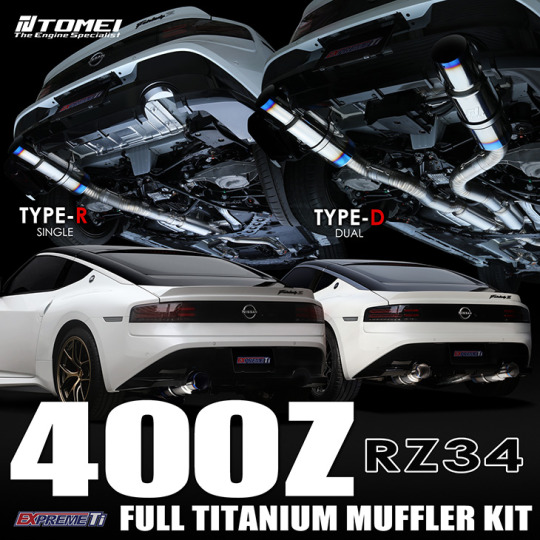
New Post has been published on https://www.vividracing.com/blog/new-tomei-expreme-ti-full-titanium-exhaust-system-for-nissan-z-rz34/
New Tomei Expreme Ti Full Titanium Exhaust System for Nissan Z RZ34
Revving into the year 2022, the automotive world was abuzz with anticipation for the arrival of the new Nissan Z. And oh boy, did Nissan deliver! The Z34, equipped with a roaring 3.0L VR30DDTT Twin Turbo V6 and a thrilling 6-speed FS6R31 manual transmission, finally met the cravings of drivers left yearning for more in its predecessors, the Z34 and R35.
Enter Tomei, the legendary powerhouse in automotive tuning since its inception in 1968. Tomei’s legacy in motorsport and commitment to excellence has birthed the Expreme Ti Full Titanium Muffler Kits. Crafted with top-tier materials and engineered for supreme performance, these mufflers are the dream upgrade for enthusiasts seeking to unleash the true potential of this iconic sports car.
View Complete Tomei Catalog Here
For the Nissan Z enthusiasts craving the lightest exhaust system imaginable, Tomei introduces not one, but two, Expreme Ti exhaust systems! The Type-R single muffler kit and the Type-D dual muffler kit promise to take your Z’s performance and sound to the next level.
The Expreme Ti Full Titanium Mufflers for the Nissan Z are lightweight, strong, and highly durable. Tomei sources its own raw materials, which allows them to significantly improve quality while also keeping prices low. Using titanium maximizes weight reduction and durability while simultaneously providing that tantalizing racing note.
SILENCER CASE
This part is made from Titanium with the pipe size of Φ152 and 1mm thickness.
The oversized shell design optimizes exhaust gas flow which helps with power gains.
Then with the embossed Tomei logo and beautiful heat gradation colouring gives it the finishing touch that you’d expect.
PUNCHED MESH
Made entirely from Titanium of 1mm wall thickness and with the open slot ratio of 32.6%. With the combination of light weight Titanium material, the high flow design delivers a really nice racing exhaust sound.
GLASS WOOL
The long fiber wool threads were adopted for the silencer.
This type has proven to last longer than the traditional fiberglass materials even over a longer period of time with extensive high temperature exposure both at high and low pressures.
Flange
Flanges are cut from 8mm thick titanium, making them more resist to cracking and warping. In addition, the opening diameter is kept the same as stock to ensure a secure seal.
Type- R Single:
This new exhaust utilizes thin (1mm wall thickness) titanium piping with a single exit design. The midsection is connected with springs and clamps instead of flanges. With large 3.5 inch (89.1mm) piping, this exhaust offers significantly more flow than the OEM exhaust, which results in more power.
Compared to a Factory Nissan Z exhaust, the Tomei Expreme Ti is 29.7lbs lighter!
*32.3lbs lighter when paired with Tomei Full Titanium Y Shape Mid Pipe!)
1mm wall thickness thickness
Titanium construction
Light, strong, and durable
Single exit design
Sounds great!
More power!
Complete Kit: This kit includes all of the necessary components for a seamless installation, including the bolts and nuts. Bolt Smooth Paste is also included to help prevent the bolts from becoming seized under extreme heat.
Part Number: TB6090-NS21C
Product Name: FULL TITANIUM MUFFLER KIT EXPREME Ti 400Z RZ34 TYPE-R
MSRP: $1,290.00
Specification:
Material: Titanium
Main Pipe Diameter: 3.5in
Main Pipe Thickness: 1mm
Main Silencer Diameter: 6in
Main Silencer Thickness: 1mm
Sub Silencer Diameter: 4.7in
Sub Silencer Thickness: 1mm
Exit Diameter: 4.5in
Exit Thickness: 1mm
Fitment:
2023+ Nissan Z RZ34 VR30DDTT
Learn More and Purchase the New Tomei Type-R Full Muffler Kit Here.
Type-D Duel:
For those who wants to keep the duel exhaust system for your new Z, the Type-D style is what you need! This new exhaust utilizes thin (1mm wall thickness) titanium piping with a duel exit design. The midsection is connected with springs and clamps instead of flanges. With large 80.5mm piping, this exhaust offers significantly more flow than the OEM exhaust, which results in more power.
Compared to a Factory Nissan Z exhaust, the Tomei Expreme Ti is 17.4lbs lighter!
*20.0lbs lighter when paired with Tomei Full Titanium Y Shape Mid Pipe!)
1mm wall thickness
Titanium construction
Light, strong, and durable
Single exit design
Sounds great!
More power!
Complete Kit: This kit includes all of the necessary components for a seamless installation, including the bolts and nuts. Bolt Smooth Paste is also included to help prevent the bolts from becoming seized under extreme heat.
Part Number: TB6090-NS21D
Product Name: FULL TITANIUM MUFFLER KIT EXPREME Ti 400Z RZ34 TYPE-D
MSRP: $1,990.00
Specification:
Material: Titanium
Main Pipe Diameter: 3.2in
Main Pipe Thickness: 1mm
Main Silencer Diameter: 6in (x2)
Main Silencer Thickness: 1mm
Sub Silencer Diameter: 4.7in (x2)
Sub Silencer Thickness: 1mm
Exit Diameter: 4.5in (x2)
Exit Thickness: 1mm
Fitment:
2023+ Nissan Z RZ34 VR30DDTT
Learn More and Purchase the New Tomei Type-D Full Muffler Kit Here.
FULL TITANIUM Y SHAPE MID PIPE:
Compared to a Factory Nissan Z Mid Pipe, the Tomei Titanium Y Pipe is 2.7lbs lighter!
Part Number: TB6110-NS21A
Product Name: FULL TITANIUM Y PIPE KIT EXPREME TI Q50/Q60/400Z
MSRP: $890.00
Specification:
Material: Titanium
Main Pipe Diameter: 2.5-2.76in
Main Pipe Wall Thickness: 1mm
Flange Thickness: 8mm
Fitment:
Nissan VR30DDTT / VQ37VHR 400Z RZ34 / Q50 / Q60
Learn More and Purchase the New Tomei Full Titanium Y Shape Mid Pipe Here.
If you have questions, please contact us. You can reach us by phone at 1-480-966-3040 or via email at [email protected].
#2023 Nissan Z exhaust#400z#exhaust#Light weight#Nissan 400Z#Nissan Z#rz34#tomei#Tomei Exhaust#twin turbo#V6#vr30#VR30DDTT
2 notes
·
View notes
Text
Performance Boost: Top Aftermarket Exhaust Systems for Your Chevrolet Corvette
If you're a proud owner of a Chevrolet Corvette, you know that the thrill of the open road is amplified when your car is firing on all cylinders. One of the most effective ways to unlock the true potential of your Corvette is by investing in a high-quality aftermarket exhaust system. In this guide, we'll delve into the world of performance-boosting exhaust upgrades, exploring the top choices for your Chevrolet Corvette.

Understanding the Role of Exhaust Systems in Performance
Before we dive into specific aftermarket options, let's first understand why upgrading your exhaust system matters. The exhaust system plays a crucial role in the overall performance of a vehicle. It's not just about making a statement with a deep, resonant tone – it's about optimizing airflow, reducing backpressure, and ultimately squeezing out every bit of power from your Corvette's engine.
Key Factors to Consider When Choosing an Aftermarket Exhaust System
When it comes to selecting the right aftermarket exhaust system for your Chevrolet Corvette, several factors should influence your decision. Compatibility with your Corvette model is paramount, but you'll also want to consider the material, design, and the desired sound level. Striking the right balance between performance and acoustics is key.
Borla Performance Exhaust System: Unleashing the Power
One name that stands out in the realm of aftermarket exhausts is Borla. Renowned for its commitment to performance, Borla offers exhaust systems specifically engineered for Chevrolet Corvettes. The use of high-quality materials, precision craftsmanship, and a focus on delivering power gains make Borla a top choice for Corvette enthusiasts.
MagnaFlow: The Perfect Harmony of Performance and Sound
For those seeking a harmonious blend of performance and sound, MagnaFlow is a name to reckon with. With a reputation for producing exhaust systems that deliver both power and an exhilarating tone, MagnaFlow has become a go-to option for Corvette owners looking to enhance their driving experience.
Corsa Performance: Precision Engineering for Maximum Power
Precision engineering takes center stage with Corsa Performance. With a dedication to extracting maximum power from your Corvette's engine, Corsa's exhaust systems are designed to deliver uncompromising performance. Whether you're tearing up the track or cruising the streets, Corsa ensures your Corvette performs at its peak.
Installation Tips and Considerations
Installing an aftermarket exhaust system can be a rewarding DIY project, but it's essential to approach it with careful consideration. This section provides valuable tips and considerations for a seamless installation process, addressing common concerns and offering troubleshooting advice.
Dyno-Tested Performance Gains: Real Numbers That Matter
Curious about the real impact of aftermarket exhaust systems on performance? We present dyno-tested data showcasing tangible improvements. These real numbers speak volumes, demonstrating the substantial gains that Corvette owners can experience by choosing the right aftermarket exhaust system.
User Reviews: What Corvette Enthusiasts Have to Say
To provide a comprehensive perspective, we've gathered insights from Corvette enthusiasts who have taken the aftermarket exhaust plunge. Real user reviews offer valuable feedback on the pros and cons of different exhaust systems, helping you make an informed decision based on the experiences of fellow Corvette owners.
Conclusion
In conclusion, the right aftermarket exhaust system has the potential to transform your Chevrolet Corvette's performance and elevate your driving experience. Whether you lean towards the precision of Corsa, the power of Borla, or the harmonious blend of MagnaFlow, upgrading your exhaust system is a tangible way to unleash the true power of your Corvette. Explore your options, consider user feedback, and take the leap toward a performance boost that goes beyond the ordinary. Your Corvette deserves it.
#c7 corvette car cover#lime rock green corvette#c3 corvette jack points#c7 corvette rear diffuser#corvette accessories online#c6 corvette forum#c6 corvette for sale forum#corvette c7 forum#hertz corvette for sale
2 notes
·
View notes
Text
A Closer Look at the Mustang EcoBoost: How Does it Achieve High MPG?

The Ford Mustang has been an emblem of American muscle cars for generations, celebrated for its power and performance. However, the introduction of the Mustang EcoBoost MPG brought a remarkable shift to the iconic pony car's legacy by placing a significant emphasis on fuel efficiency. In this article, we will take a closer look at the Mustang EcoBoost and uncover the secrets of how it achieves high miles per gallon (MPG) without sacrificing its exhilarating driving experience.
The Turbocharged Heart of the Mustang EcoBoost
At the heart of the Mustang EcoBoost's impressive fuel efficiency is its innovative 2.3-liter inline-four-cylinder engine. Unlike the traditional V8 engines that have dominated the Mustang lineup, the EcoBoost boasts a turbocharged powerplant. Here's how this turbocharged engine contributes to high MPG:
Turbocharging and Direct Injection
The turbocharger is a small but powerful device that compresses the air entering the engine, allowing more air to be forced into the combustion chamber. This process, known as forced induction, significantly increases the engine's efficiency by providing more oxygen for combustion. Coupled with direct fuel injection, where fuel is sprayed directly into the combustion chamber, the Mustang EcoBoost's engine can produce more power from less fuel.
Smaller Displacement, Better Efficiency
The smaller displacement of the four-cylinder engine means less internal friction and energy loss compared to larger V8 engines. Smaller engines inherently require less fuel to operate, and this plays a pivotal role in achieving high MPG. The Mustang EcoBoost's engine achieves a fine balance between power and efficiency.
Variable Valve Timing
The EcoBoost engine features advanced variable valve timing, allowing it to optimize the timing of intake and exhaust valve openings. This technology ensures that the engine operates at peak efficiency across a wide range of speeds and loads. It adapts to driving conditions to provide both power and fuel savings.
Aerodynamic Efficiency
Another key factor contributing to the Mustang EcoBoost's high MPG is its aerodynamic design. While the Mustang is celebrated for its classic styling, Ford engineers have incorporated modern aerodynamic elements to enhance efficiency:
Sleek Body Profile
The Mustang EcoBoost features a sleek body profile designed to minimize wind resistance. This streamlined shape helps the car cut through the air more efficiently, reducing the energy required to maintain speed. This is especially beneficial during highway driving, where the Mustang can achieve optimal fuel economy.
Active Grille Shutters
The Mustang EcoBoost incorporates active grille shutters that automatically open and close to control airflow to the engine. When additional cooling is not required, these shutters close to reduce drag, making the vehicle more aerodynamic. When more cooling is needed, such as during intense acceleration, the shutters open to provide maximum airflow.
Technological Advancements
The Mustang EcoBoost is not only about its engine and design; it also leverages advanced technologies to further improve fuel efficiency:
Start-Stop System
The Mustang EcoBoost is equipped with a start-stop system that automatically shuts off the engine when the vehicle comes to a stop and restarts it when you release the brake pedal. This feature eliminates unnecessary idling, saving fuel in city traffic and stop-and-go situations.
Driving Modes
The Mustang EcoBoost offers different driving modes, including an "Eco" mode. In this mode, the engine and transmission are adjusted to prioritize fuel efficiency. While it may reduce the car's responsiveness slightly, it's a valuable tool for conserving fuel on long drives or in heavy traffic.
Lightweight Materials
To further enhance fuel efficiency, the Mustang EcoBoost incorporates lightweight materials in its construction. Components like aluminum are used to reduce overall weight without compromising structural integrity. A lighter vehicle requires less energy to accelerate and maintain speed, thus improving MPG.
Conclusion
The Ford Mustang EcoBoost represents a remarkable evolution of the iconic muscle car, combining power and performance with a focus on fuel efficiency. The innovative turbocharged engine, aerodynamic design, and advanced technologies work in harmony to deliver impressive MPG figures. The Mustang EcoBoost demonstrates that performance and fuel efficiency can coexist, setting new standards for the sports car category. As we move towards a more environmentally conscious future, the Mustang EcoBoost showcases the adaptability and sustainability of a legendary American classic.
2 notes
·
View notes